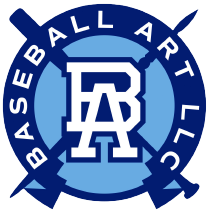This is probably the most frequently asked question I have encountered.
Unknown Player

I believe there is no real precedent for the scope of painted portraits displayed in the book Black Baseball In Living Color, The Artwork of Graig Kreindler, an effort that took the better part of four years. The Perez Steele sets of baseball cards and subsequent book are magnificent works of art, but focus solely on National Baseball Hall of Fame players whereas our portraits are a mixture of both Hall of Fame inductees and others, including even an “Unknown Player” with Brown’s Tennessee Rats. Other artists have been prolific including my friend Monty Sheldon and my internet friend Arthur Miller. Their artwork is also remarkable, but to my knowledge has not been treated as a subject of a book.
So how did these Kreindler paintings come to be selected? The book explains how this project came about, but does not explain why certain players are included, sometimes more than once, while others are excluded. The answer is fairly straight forward.
First our objective was to highlight as many Negro Leagues players as was possible in time for the celebration of the Negro Leagues Centennial in February 2020 at the Negro Leagues Baseball Museum. Our secondary goal was to depict as many Negro Leagues teams as possible through their uniforms including barnstorming teams, touring teams (1945 American All-Stars), and Latin baseball league teams. But as with any project, there are constraints placed upon you.
Dizzy Dismukes

Our first constraint was finding and licensing photographic images. Compared to the White Major Leagues, there are very few Negro Leagues photos available. Once you have found a photo, you have to determine who, if anyone, (a) owns the rights to it, (b) are the licensing fees reasonable, and (c) is the quality sufficient for Graig to create his magic. As you are aware, Graig specializes in the fine details of a player, a uniform, and the lighting. I cannot remember how often I would return a “finished” painting to Graig who would notice from another photo a detail that had eluded him originally. Graig is a perfectionist. We ended up rejecting several players simply based on the fact we could not find a suitable image. Judy Gans was one such example. We would have loved to have included his image, but could not find an image with sufficient detail and clear ownership of licensing rights.
Our second limitation was time. This project started in 2016. Ideally it would have started out in 2014 or earlier and we would have completed a master list of all player portraits we wanted to do along with the uniforms in which the player was depicted. But we soon found out finding so many portraits was time consuming. There is no universal catalogue of Negro Leagues photos. We asked the “usual suspects” – Ryan Christoff, Phil Dixon, Larry Lester, Mark Rucker, RMY Auctions, the Negro Leagues Baseball Museum, and the Negro Southern League Museum Baseball. We also followed up with other auction house when they posted potentially usable images requesting if we could obtain the image for use. But all of that takes time. On more than one occasion, we had already committed to a player’s portrait when we found another that would have been more suitable, perhaps a different uniform, but had to press forward with what we had already licensed.
Time also played a factor in completing the project in time for the Negro Leagues Centennial on February 13, 2020. The NLBM only received 230 paintings, the balance was not finished until later, but were displayed between May and August 2022 for a reprise of the show.
Time, and money, also plays a factor in our answer to why we don’t continue adding to the collection. The last time we spoke on the subject, Graig had a seven-year backlog of commissions. Each of these 5” x 7” portraits take, on average, a week to complete including the necessary research. Graig is worried one of his existing clients who are waiting for their painting will take out a contract on him. I don’t want to be complicit in Graig’s demise. In addition, I paid Graig for each painting. The intent was, and is, to create products based on Graig’s paintings, but we are at a point of diminishing returns. Satchel Paige is much more popular and leads to more product sales than say Frank Warfield. This is largely why Cool Papa Bell, Rube Foster, Josh Gibson, Satchel Paige and Jackie Robinson had multiple paintings included in the book. They were popular both in their time and now, were the subject of many photos, and lent themselves to multiple products.
Vic Harris

A final consideration is the uniforms. We wanted to showcase as many teams as was possible, but not surprisingly, the most photographed teams were the most successful and popular. This worked out well for the Kansas City Monarchs and Pittsburgh Crawfords. Both teams frequently changed their uniform and sometimes wore multiple uniforms in the same year allowing for a variety we are pleased to display in the book. But other wildly successful teams, the Homestead Grays and Newark Eagles both come to mind, did not change their uniforms. To the extent we could, we shied away as much as possible from them. In the end, the constraints imposed upon us largely dictated who Graig painted and, therefore, who is included in the book.

